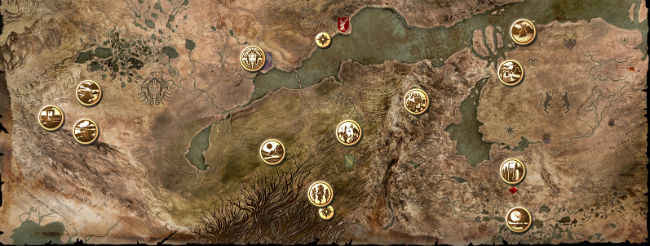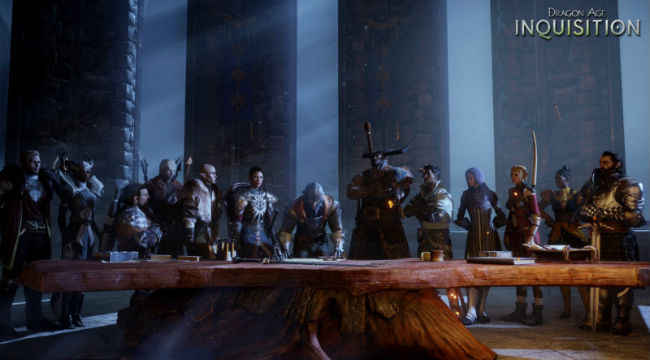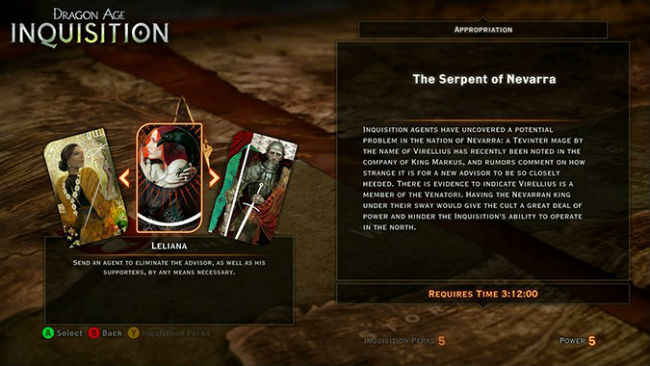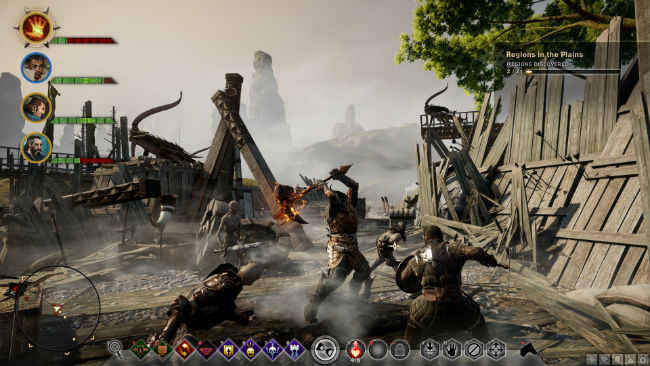
Our Verdict
Dragon Age: Inquisition is the best game of the year; the best game in the Dragon Age series; one of the finest games that Bioware has ever made and a great benchmark for what a modern day RPG should be.
The absolute best moment I’ve had in Dragon Age: Inquisition so far was facing off against a dragon that used electricity as a weapon, in a swamp.
The dragon’s attacks meant that I had to constantly move the mages in my party out of the water and keep my melee fighters up close and focused on hobbling one of the dragon’s legs. Twenty minutes down the line, three of my party members were incapacitated, my healing potion counter was at zero and there was still a sliver of red left in the dragon’s health bar. I somehow managed to evade the crackling ball of static the dragon threw my way, lunged ahead thrice, praying that I didn’t end up standing for too long in a pool of water, and when I was in the shadow of the dragon’s wing, I enabled my defensive mode and started hacking at its legs in a last ditch attack. The dragon roared and stunned me for a few precious seconds while it tried to turn in order to spot me. Fortunately, the stun effect dissolved before it could completely turn around, so I lunged ahead again and hit it with my most powerful offensive capability: the Shield Bash. The dragon let out a huge roar and lifted its neck up, almost gracefully, before crashing down, dead. The silence that followed only magnified the sense of achievement that I felt.
This isn’t Skyrim, that’s for sure.
At the time of writing this, I’m almost 85 hours into Dragon Age: Inquisition and I still have some ways to go before I finish it. But of course, that’s just me and my completionist ways. Even if you don’t 100% every area in Inquisition, you’ll still end up spending about 40 to 50 hours in the game, and that perfectly represents the core motive behind the new Dragon Age game.
Dragon Age: Inquisition clearly wants to erase the bad taste that Dragon Age 2 left behind in the mouths of many gamers. Now, I belong to the silent minority that actually liked Dragon Age 2, despite its significant flaws, but even I have to admit that Inquisition one-ups the 2011 game in almost every possible way. One of the big complaints about DA 2 was that it re-used environments; Inquisition has a host of different areas that look very different from each other. Hated that you were confined to a single city (and its neighbouring areas) in DA 2? You get to explore a number of towns and villages in Inquisition, with one area almost as large as the entire city of Kirkwall from DA 2. Were you depressed that you could only play as a human in DA 2? Inquisition lets you create characters from a pool of races that even outshines Dragon Age: Origins in terms of numbers. I could keep going on and on but you get my drift.
So, yes, Dragon Age: Inquisition is the best game of the year; the best game in the Dragon Age series; one of the finest games that Bioware has ever made and a great benchmark for what a modern day RPG should be.
The World
If you’ve played any fantasy game in the past, you’ll find yourself slipping into Inquisition’s world comfortably. Even when I first played Dragon Age: Origins back in 2008, its game world was really nothing new. The Dragon Age universe is set in the fantasy continent of Thedas (THE Dragon Age Setting) that embraces most established fantasy tropes, in that it is made up of gargantuan cities, forests, wastelands and dotted with small villages and towns, populated by humans, elves, dwarves, dragons, demons and various beasts. While the first Dragon Age game was contained within the nation of Ferelden (think medieval England) and the second within the Freemarcher city of Kirkwall (think one of the Renaissance period European city states), Inquisition spans the kingdoms of Orlais (think Medieval France) and Ferelden.

Where the Dragon Age world sets itself apart is in the way it adapts real world social issues into its story and lore. While playing the game, you’ll run across a wide variety of characters some of whom are racists, addicts, religious fanatics and anarchists. Of course, since this is a video game, you also get purely evil characters who would put most sociopaths to shame. However, by and large, characters in the game are never purely white or black and always have some shades of grey and nobody exemplifies that better than your inner circle.
The Inner Circle
In Inquisition, the Inner Circle consists of both the playable members of your team and the ones that are essential to the game but cannot be controlled. Revealing the identities of some of these core NPCs could be considered as spoilers, so I’ll refrain from that. Suffice to say, if you’re a fan of Dragon Age, you’ll see some familiar faces.

You get to hire a total of nine playable team members, three of who will always accompany you on your adventures. As always, Bioware does a great job of humanizing them and giving them a variety of back stories and motivations. As a result, you’ll always enjoy talking to them and developing friendships and romances. Of course, some companions are better than the others but I can’t single even one of them out for being outright terrible. Even a warrior companion who starts out drab and boring, ends up becoming interesting thanks to a neat twist about halfway through the game.
If you’ve been a fan of the great repertoire of characters from past Bioware games, I’m happy to tell you that you’ll like what Inquisition has to offer. Maybe one of these characters will even stand alongside Garrus Vakarian or HK-47 as your favourite Bioware character.
The Story
The Dragon Age games have always boasted of expansive, deep storytelling and Inquisition’s no different. It is however, more classic Bioware than its predecessor, and by that I mean the game uses many of the tropes that the developers have used in older games. Games like Mass Effect, Mass Effect 2 and Knights of the Old Republic featured a world threatening event that could be averted if the hero travelled to different areas to recruit allies and Inquisition’s story falls along the same lines. It stars you as a hero who has been incomprehensibly saved from certain death and granted the power to stop demons from entering the world. You soon uncover an ancient evil and a conspiracy that could destroy the world and you have to set off to strengthen your order, the Inquisition, to fight against the evil. While the story sounds very generic, it’s the smaller plot elements that make the game’s story worth playing through.

Inquisition is also perhaps the most ‘high fantasy’ of the Dragon Age games and focuses less on darker subject matter than its predecessors. I did miss Origins’ focus on dirty politics and heroes with compromised ideals. In fact, one of the opening scenes in Origins when Duncan, the Grey Warden, kills an innocent man who doesn’t want to become a Grey Warden, remains one of the most shocking I’ve witnessed in a game. I also missed Dragon Age 2’s decision to fixate on topics like racism, slavery and sexual politics. Compared to its predecessors, Inquisition’s story appears cleaner, with less rough edges, more ‘The Fellowship of the Ring’ than ‘A Storm of Swords’. Which one you prefer will determine whether you find Inquisition’s story better than its predecessors.
The Gameplay
Inquisition doesn’t exactly break the mould of Bioware’s previous games and is primarily focused on talking and combat with just a hint of puzzle solving. However, there are a couple of new things, including an overarching ‘War Table’ metagame (similar to Mass Effect 3’s Readiness Rating metagame) which requires you to direct your forces to solve various issues on a map. Fortunately, these missions are interesting because they’re directly tied to the main plot or to one of your companions and, therefore, never feel unnecessary or boring. One issue is that the metagame’s interface does not gel with the some of the game’s components. For e.g. if you set a quest as active in your journal and it requires you to first complete a mission through the War Table, the quest doesn’t get marked as active on the War Table map. As a result, you’re forced to mouse over the dozens of quest icons that populate the map to see which one fits the bill.

The War Table issue is not the only interface related issue in Inquisition. Scrolling through your and your party’s inventory feels like pointless busywork because the interface has clearly been designed for a controller and not a mouse. I ended up setting aside about 20 minutes every two hours just to manage my party’s inventory and craft/upgrade weapons and armour. After the horrendous interface we were saddled with in Skyrim, I’m surprised that AAA RPGs still haven’t managed to design a usable interface for inventory management. Thankfully, while they are annoying, Inquisition’s interface issues didn’t spoil my overall experience.

Conversations in Inquisition play out almost as mini-games with you deciding from among a bunch of responses. Sometimes you get special options depending on your race, background, choices you’ve made so far and your attitude towards the person you’re speaking to. While Origins had complete verbose dialogues with clear alignments as your choices in a conversation and Dragon Age 2 had a dialogue wheel mostly with ‘honourable’, ‘snarky’ and ‘evil’ as your only choices, conversations in Inquisition feel more organic. Your conversation choices still make their alignment clear but the way conversations branch out following the initial thread, makes dialogue sound more natural. Of course, since you’re still essentially playing a character who is a blank slate, some conversations have a tendency to become more stilted as they progress but that’s largely limited to conversations in which you’re fishing for lore.

While Inquisition keeps its combat interesting and challenging, I thought it had the worst combat mechanics of all the Dragon Age games. It appears like Bioware tried to toe the line between the absolutely tactical combat of Origins and the more free-flowing combat of Dragon Age 2 and ended up with something that was weaker than both. While Inquisition’s combat works well for mages, it falls short for melee fighters. This is because combat animations and movement don’t happen at the same time, which means that I often found my sword and shield warrior swinging at thin air after my target had moved. Inquisition also has a tactical mode which can be initiated by pulling back the camera all the way with the mouse wheel. Initially, this mode was useless thanks to the fact that the camera wouldn’t pull back by much and it was a pain to move it to view the battlefield but, since then, EA has pushed out an update that lets you strafe the camera easily and that, honestly, makes a big difference. Since the update, I prefer using the tactical camera when it comes to large scale battles while I stick to the hack and slash mode when there are just a couple of foes. So, yes, Inquisition’s combat falls short of its predecessors but, just like the interface, it doesn’t mess up in a manner that ruins the game.

The blindingly bright spot with respect to the combat are the dragon battles. The game has 10 dragons and fighting every single one of them is an exhilarating, challenging and, ultimately, rewarding experience. While all (but one) one of these battles are optional, I’d recommend you play them. Not only will you be able to acquire powerful gear and crafting materials but you’ll also have a tremendous amount of fun. Every dragon battle can span anywhere from ten minutes to half an hour and will require you to employ tactics, strategy and get a good hold on the tactical abilities of every party member. Every dragon is also different and while one will often fly up and blast you with homing fireballs, another will call smaller dragons to its side, making every battle unique.

The Graphics and Performance
I’m playing Dragon Age: Inquisition on a thoroughly mid-range PC with the following specs:
Intel Core i5-4430 (3.2GHz quad-core)
Gigabyte GeForce GTX 660 (2GB)
8GB RAM
I was disappointed to see that I couldn’t run the game at high settings and had to tweak things around to get above 30 fps consistently. Now, with some settings at high and some at medium, the game is mostly smooth but I still do run across stuttering at times. A bigger issue was the random Direct X crash that wouldn’t even let me start the game. After delving into forums, I realised that while there were some solutions, none of them were definite. Ultimately, after deleting profile folders, manually changing graphics settings through my card’s control panel and restarting my system, the game started working again and I still don’t know what fixed it.

Inquisition is a pretty game overall that’s not afraid to use colour to help you differentiate the different locales. Unlike most games that tend to use a limited colour palette to generate a particular feel, Inquisition does that for individual locations. As a result, you get the Storm Coast that’s grey and mossy green, the Hinterlands that’s yellow, blue and light green, the deserts of the Forbidden Oasis that are sandstone orange and blue and the forests of the Arbor Wilds that are just brimming with everything from the easel. On the other hand, Inquisition is not a visually sharp game, the way Far Cry 4 is. Textures are generally muddy, character faces aren’t as realistic as you’d expect from a Frostbite engine game (unlike, for instance, Battlefield 3) and a lot of the environmental elements (trees, plants etc.) don’t look very detailed. Of course, I’m not running the game at max settings but I still feel that Bioware could have done more to make the game look sharper on less powerful systems.
The Bottomline
There’s no denying that Dragon Age: Inquisition has its flaws, some of them, quite serious. But there’s also no denying that it represents Bioware at its best. Inquisition affirms that Bioware still remains one of the finest developers of Western RPGs alongside Bethesda, Obsidian, CD Projekt and Blizzard.
Of course, I can’t end this review without touching on the fact that you can’t actually buy Inquisition in India because of the archaic, immensely stupid and inhumane homosexuality laws in force here. I wish that EA had summoned up the nerve to go ahead with the launch because there was very little chance that it would have fallen under the scanner. Nevertheless, if you still want to play Inquisition, you can use VPN and purchase the game from multiple online avenues.
I’d suggest you do that and not miss out on one of the finest RPGs in recent years.
Note: Dragon Age: Inquisition also has a multiplayer mode, but I haven’t spent more than five minutes playing it. I will update this review once I put in more hours into it.

No comments:
Post a Comment